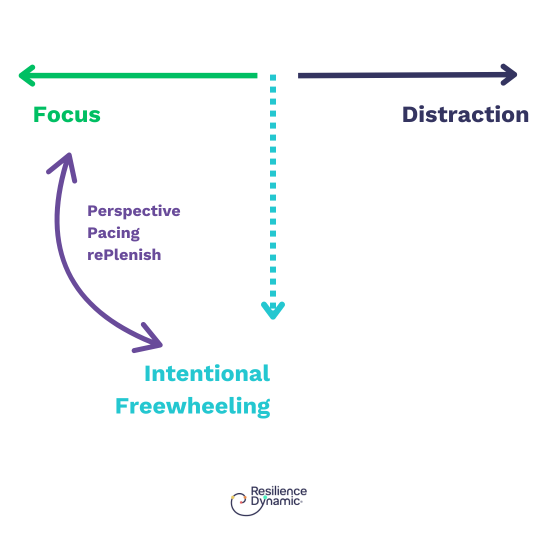Rediscovering The Ability To Focus
How To Optimise Brain Power Through The ‘65/35 Rule’
In organisations, focus seems to be king. But is it?
If you’re not focussed, the assumption is that you must be distracted, and that doesn’t lead to anything useful. It’s a stark choice:
Distraction = BAD
Focus = GOOD

The Context
You probably feel the pressure to deliver. Today. Now. You and your bosses value productivity and efficiency. You may feel you need to do more with less. You are told to keep pushing on. You seek to focus everyone, including yourself. How to achieve focus becomes part of the worries piling up in front of you. It’s elusive. It’s necessary but you can’t catch how to keep your team’s focus. But you need to keep trying.
If this kind of thought process is running in your team, the idea of deliberately switching off will seem entirely counterintuitive, even ridiculous. Yet the research insights from Standford, Harvard Business Review, our own research in the Resilience Dynamic and many others tells us something quite different: too much focus undermines the ability to think clearly and make good decisions. Indeed, too much focus leads to brain size contraction; you are lessening your intelligence! You need to switch off.
The Cost of Distraction
At the Resilience Dynamic, we witness how our client’s attention is constantly being trapped in an attention battleground—an endless cycle of meetings, emails, app notifications, and urgent-but-not-important demands. You can start the day with a clear plan, all energised and raring to go after your decent breakfast and gym session. But by lunchtime, it’s gone awry. You find yourself derailed by reactive firefighting.
The cost of this is high. Decision making is weakened and productivity drops. Innovation is out of the window. Stress is increased with all its health risks. Burnout risk is growing.1 But there are even more implications. Your team is affected. As a leader, you set the ‘mood music’. If you are constantly distracted, your team feels it. They take their cues from you—if you’re always scattered, firefighting, and reacting rather than leading with intention, that becomes the team’s culture. It’s so easy to lose sight of how you operate, you cannot see yourself from the outside in.
What’s more insidious is the effect on how your brain is being gradually re-wired. The modern “attention economy” is designed to exploit our psychological weaknesses, keeping everyone in a state of constant reactivity. Constant emails, Slack messages, and meeting alerts trigger the brain’s dopamine-reward system, making distractions feel good in the short term, even as they erode long-term effectiveness. Research from MIT’s Neuroscience Department shows that every time you check your phone or email, your brain releases dopamine—the same chemical associated with addiction. The result is a compulsive cycle where you think you’re being productive, but in reality, you’re just spinning your wheels.2
What is most frustrating about this? You know this is happening, but you can’t seem to stop it.
Introducing The Resilience Dynamic’s ‘65/35 Rule’
The Resilience Dynamic’s early insights included the ‘65/35 Rule’.
To achieve the highest level of resilience, allocate your time to spend ~65% of your time focussing on ‘doing’, keeping 35% of your time to foster what we call ‘Adaptive Capacity’ – the combination of perspective, pacing and replenishing which gives us the edge to be change-ready. Your resilience is your capacity and capability for change; its measure is your capacity for change. If your resilience runs dry, your capacity is nil and however busy you are, you will not be able to drive change.
Take a moment to consider the implications of that 35% portion. Just over one whole third of your time spent on sense checking, re-energising, deliberately seeking perspective far and wide. This 35%, whilst in the same domain as switching off, is more purposeful. We call it intentional freewheeling.

Intentional freewheeling is like switching off but with a request of your brain to make sense about something. Intentional freewheeling is not idleness or wasted time; it is an essential function that allows your brain to consolidate information, make new connections, and spark innovative ideas. It is, in fact, the hidden key to being able to re-focus on the right path or solution. When you treat your brain well, it refreshes and throws up new and useful ideas and thoughts.
Give your brain a question to work on, whilst you are cooking, walking the dog, doing sport, or resting. There is no need to force your brain to consider anything, the process is one of complete trust that your brain will return something after some high quality down time. Whenever, wherever. The return time can be minutes, or it could be days, or any combination. The insights may come in droplets across time. But those droplets are priceless, and will set you on a much clearer pathway, and incredibly, an unbelievable ability to refocus.
The quality of your brain’s answers however depends a lot on the quality of the switching off itself, and how intentional you allow it to be.
The ‘65/35 Rule’ in Practice
Achieving the ‘65/35 Rule’ of the Resilience Dynamic balance requires a shift in mindset. Rather than seeing switching off as a luxury or a distraction, you need to embrace intentional freewheeling, and recognise it as a strategic necessity.
Here’s how you can integrate more intentional freewheeling into your routine:
Schedule Freewheeling Time
Just as you plan focused work, schedule time for breaks, reflection, or unstructured thinking. Short walks, listening to music, or even staring out of the window can help activate your brain’s creative processes.
Embrace Downtime
Organisational culture often celebrates busyness, but true resilience comes from balancing effort with recovery. Rest, leisure, and even boredom are essential for mental agility and performance.
Engage in Mind-Wandering Activities
Activities like drawing, knitting, or gardening provide the perfect blend of mild engagement and mental relaxation, allowing your brain to make unexpected connections. They are critical.
Use Sleep as a Tool
Sleep is one of the most effective forms of switching off and letting the brain recover. It consolidates learning and problem-solving overnight. Prioritising good sleep hygiene enhances both cognitive function and resilience.
Let Go of Guilt
You may feel guilty when you step away from your tasks, believing you ought to be chained to your laptop ploughing through those emails. But productivity is not about the hours worked—it’s about the quality of thinking and decision-making. By embracing the ‘65/35 Rule’, you’re not slacking off; you’re optimising your brain’s capacity to function at its best.
Next Steps
The Resilience Dynamic is now actively researching more on focus, intentional freewheeling, and what underpins the ‘65/35 Rule’ from neuroscience. This first article is one of a series we expect to cover in the coming months, whilst we enquire into the following four questions:
What is focus?
- What is focus?
- How do we (re)learn how to focus?
- Is doubling down on focus the solution to our current attention issues? Or is there another way?
- When challenges become multitudinal and extremely complex, do we need even more than 35% to understand our possible pathways?
If you want to contribute into our enquiry, you are most welcome. We’d love your views on these four questions! Get in touch via [email protected].
Otherwise for now, think about how you might switch off today. Enjoy the intentional freewheeling experience!
If you would like to explore more about ‘The 65/35 Rule’ for yourself or your own team, look at the following resources:

Author: Jenny Campbell Founder and CEO of the Resilience Dynamic
Follow Jenny on LinkedIn for more of her thoughts, resilience research, and ideas.
Gain exclusive access to Resilience Dynamic in-depth insights
Extend your knowledge, expand your thinking into Healthy, High Performance.
Register today and get your free login to:
- Gain exclusive access to in-depth resilience insights.
- Download and share the insights with your friends and colleagues.
- Receive resilience in-depth insights and tools straight to your inbox, every month.
If you are already receiving our resilience tools via email but it's the first time seeing this exclusive access, do register. You'll get the new exclusive insights, plus be able to download all articles. Simply complete this registration form once to get your login details.
Read our privacy policy
